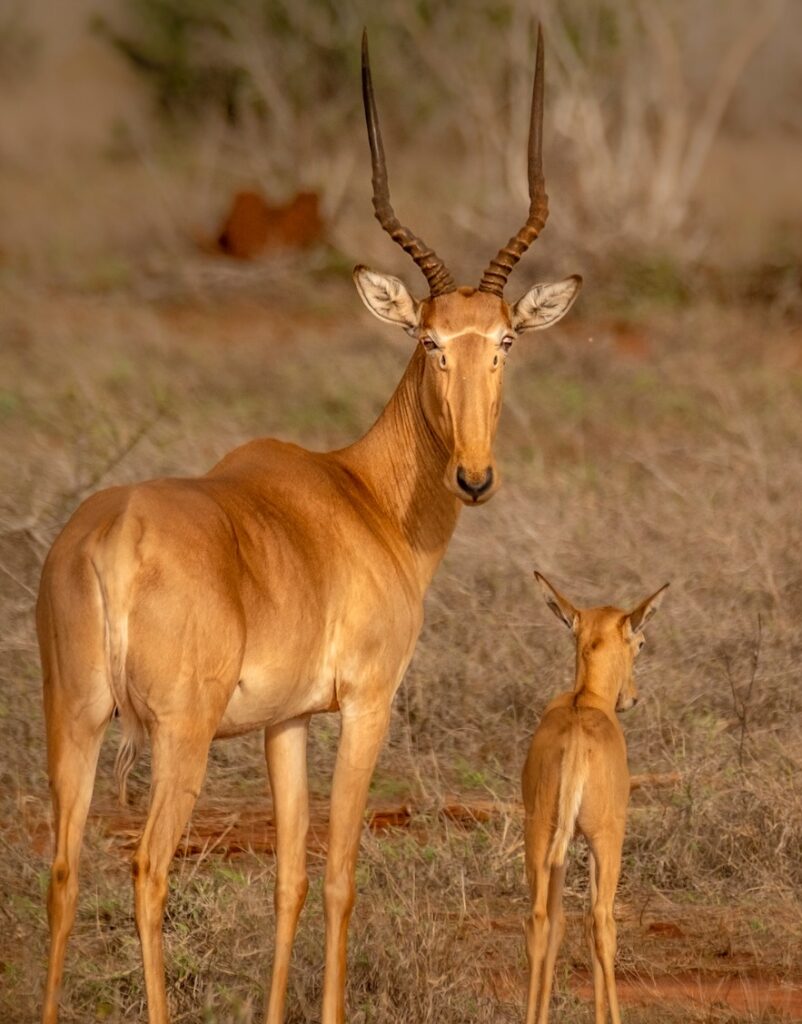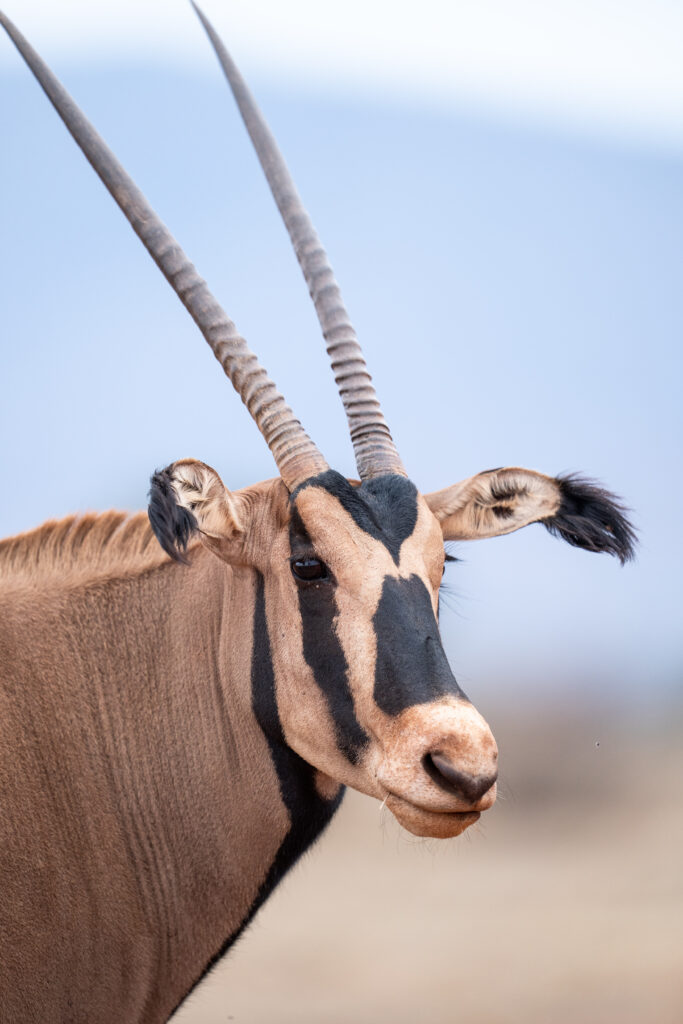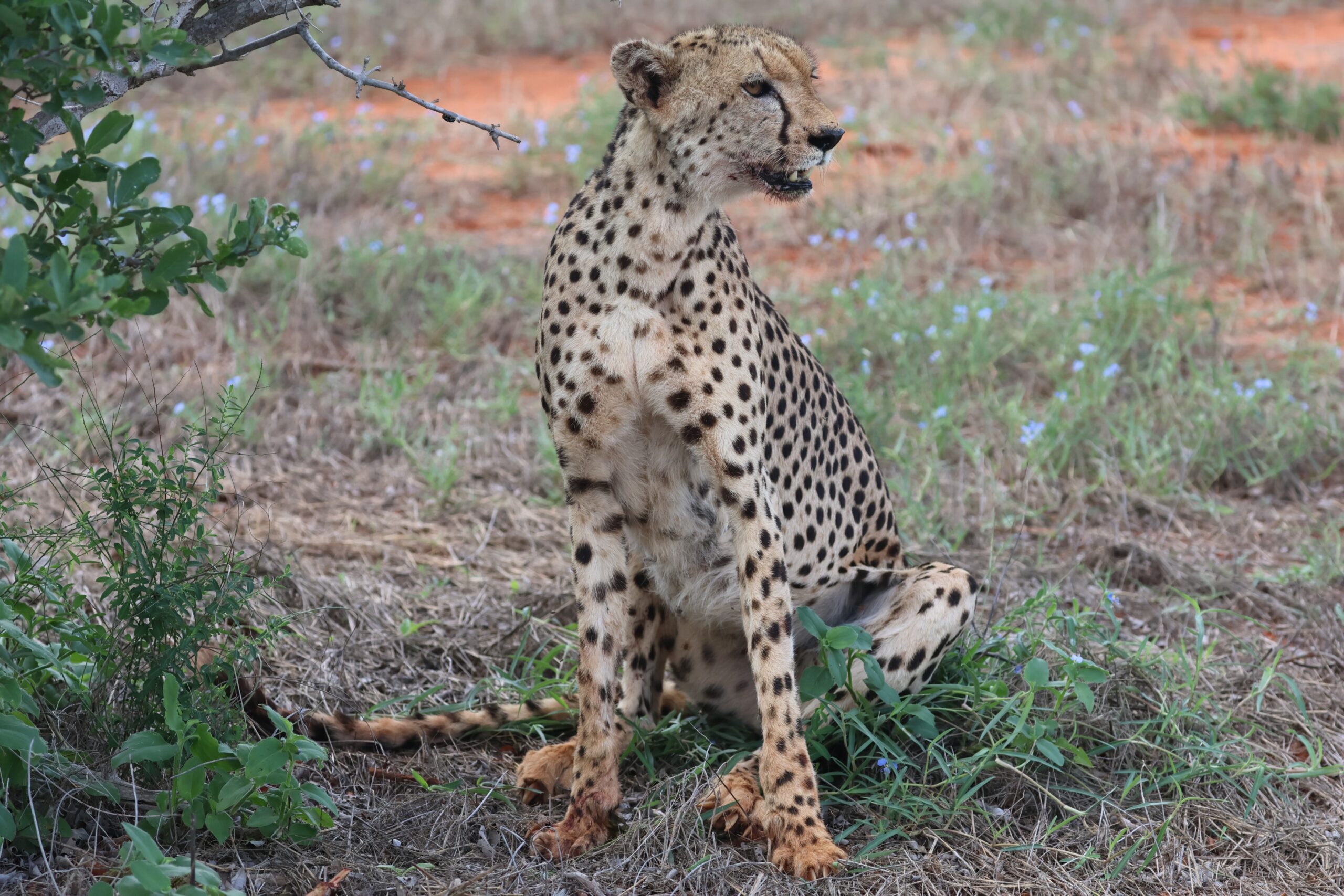Tsavo is one of Africa’s largest and most ecologically diverse protected areas—hot, dry, and vast. The animals that survive here have developed a suite of fascinating adaptations to help them thrive in this challenging landscape. From heat-resistant antelopes to cats with unusual colouration, these unique traits reflect the harsh beauty of Tsavo itself.
In this article, we explore the curious adaptations of some of Tsavo’s most iconic and elusive animals.
Lions – Kings without crowns
In the Tsavo Conservation Area, it’s common for male lions to develop reduced or no manes at all. This trait is believed to have evolved for two reasons:
-
Thermoregulation: A full mane traps heat, which is disadvantageous in Tsavo’s high temperatures.
-
Hunting efficiency: The thorny vegetation and dense bush may favour lions with less obtrusive manes that don’t snag or hinder movement.
🔗 Why Are Tsavo’s Male Lions Maneless

Hirola – The “Four-Eyed” Antelope
One of the rarest antelopes in the world, the hirola has a distinctive adaptation near its eyes:
-
Pre-orbital glands: These trenchlike slits extend from the inside corners of each eye and are lined with sebaceous and sweat glands. They produce secretions containing pheromones and other semiochemicals, which are deposited on twigs and grass as a form of communication with other hirola.
🔗 Hirola: Africa’s Forgotten Antelope

Melanistic Servals – Tsavo’s shadow cats
Between 2011 and 2016, nearly half of all recorded serval sightings in Tsavo involved melanistic individuals—among the highest rates in Africa. While the exact reason is still unclear, several theories exist:
-
Camouflage Hypothesis: Though unlikely given Tsavo’s open landscape, melanism could offer some advantage in shaded or patchy habitats.
-
Survey Bias: Black servals may be easier to spot against Tsavo’s red earth, skewing data.
-
Genetic Drift or Mutation: Melanism in servals may result from a random mutation that has become common in the population due to genetic drift or a founder effect. It may not be adaptive, but simply an inherited trait that has persisted.
🔗 Melanistic Servals: Unravelling the Mystery of Tsavo’s Black Cats

Fringe-Eared Oryx – Survival in scorching heat
The fringe-eared oryx is superbly adapted for life in arid and semi-arid environments like Tsavo:
-
Water conservation: Can survive for long periods without drinking by extracting moisture from plants and producing highly concentrated urine.
-
Heat tolerance: Can raise body temperature to 47°C (116°F) to reduce water loss via sweating.
-
Special nasal passages: Help cool blood before it reaches the brain—crucial in extreme heat.
🔗 How the Fringe-Eared Oryx Thrives in Harsh Conditions

Rhinos – Scent trails and territorial messaging
Rhinos, especially black rhinos, are known for their solitary and highly territorial behaviour. Their aggression makes visual interaction risky, so they rely on scent to communicate:
-
Dung middens: Specific spots within a rhino’s home range where they regularly defecate, serving as “information centres.” These reveal age, sex, and reproductive status.
-
Territorial marking: Dominant bulls may maintain up to 40 middens, which they use and trample to spread their scent. This spreads their scent along feeding tracks and borders, helping other rhinos avoid unnecessary conflict.
Tsavo’s Intensive Protection Zone (IPZ) provides one of the most secure habitats for black rhinos in East Africa, where these remarkable communication behaviours can be observed.
🔗 How Black Rhinos Communicate With Poop
Cheetahs – Speed machines with built-in grip
This adaptation is common to all cheetahs, but it’s particularly valuable in Tsavo’s wide-open plains, where sprinting at full speed is often necessary to bring down fast-moving prey.
Non-retractable claws: Unlike almost all other members of the cat family, cheetahs cannot fully retract their claws. Most felines keep their claws sheathed to stay sharp for gripping and climbing, but cheetahs have evolved a different strategy. Their semi-retractable claws function more like the cleats of a sprinter, digging into the ground for maximum traction during high-speed chases. This, combined with their lightweight build, elongated limbs, and oversized nasal passages for rapid oxygen intake, allows them to reach speeds of up to 112 km/h (70 mph).
Their long, muscular tails also act like rudders, providing dynamic balance and helping to steer while turning at high speed—critical in a habitat like Tsavo, where open spaces and sparse cover make high-velocity ambushes essential for hunting success.

Elephants – Tsavo’s giants with surprising sensory powers
Elephants have so many adaptations that allow them to thrive in a multitude of environments—something we cover regularly in our weekly blogs. From their highly developed brains to their tusks, elephants are a marvel of evolution. For this article, we’ve highlighted just a few adaptations especially relevant to the Tsavo context:
-
Ears as radiators: Elephants can pump all their blood through their ears in just 20 minutes, allowing them to cool their body—a vital function in Tsavo’s extreme heat.
-
Fat pads and seismic communication: Elephants are able to supplement the transfer of acoustic information through a very interesting way—using seismic waves. Their feet contain substantial cartilaginous fat pads that act as seismic sensors. This adaptation enables them to detect ground vibrations, expanding their range of communication significantly. While the full implications of this ability remain mysterious, scientists believe it aids elephants in detecting other herds and valuable resources such as water. Reports even suggest that elephants can sense earthquakes and tsunamis before they occur.
Final thoughts
From secret scent messages to the ability to detect vibrations, Tsavo’s animals have evolved extraordinary tools to meet the challenges of their environment. Whether it’s the regal lions without manes or the elusive black servals, each species reflects the evolutionary pressure of surviving in Tsavo’s extremes.


